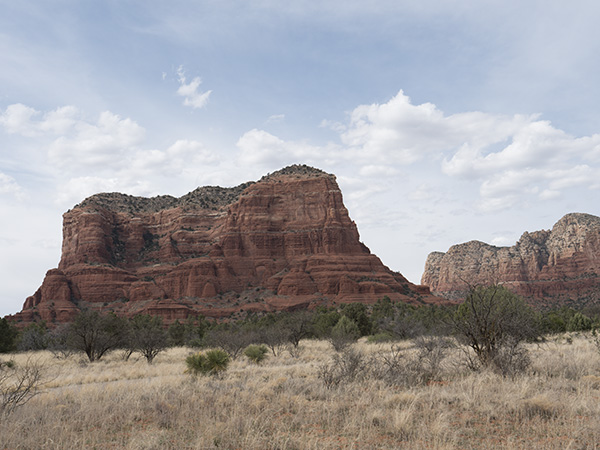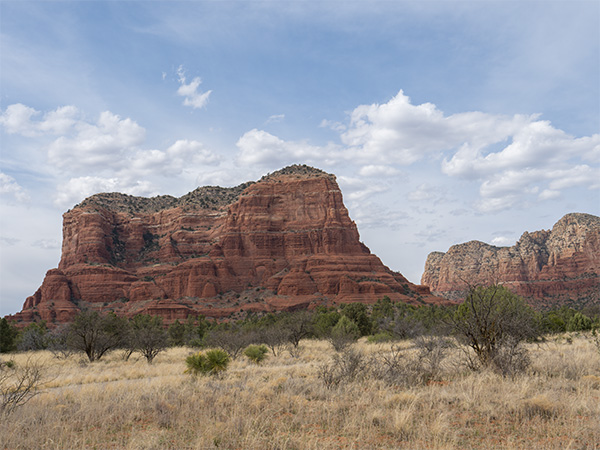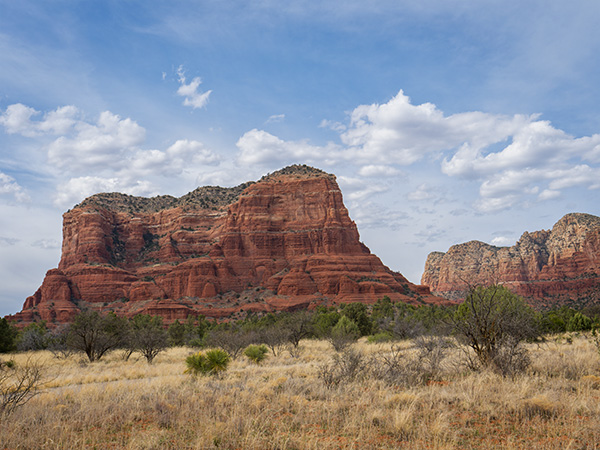Lumix G9 and Mega Files
Panasonic recently released the Lumix G9 as the stills flagship camera. Just received mine and I am exploring new features. Here is an exciting treat that will get you some serious megapixels. It’s called High-Resolution Mode. You can double or quadruple the 20 MP files size. That is correct. The G9 can serve up an eighty Megapixel file.
Below you’ll see my first test shot using the red rocks of Sedona. It doesn’t hurt to live in a place with some beautiful scenery. ; )>
Pictured below is Courthouse Butte in the Village of Oak Creek where the red rocks begin.
 Above a RAW file straight out of the camera (SOOC) with no processing in Adobe Camera RAW. (ACR)
Above a RAW file straight out of the camera (SOOC) with no processing in Adobe Camera RAW. (ACR)
 The image after a little massaging in ACR. Adjustment were made of highlights, shadows, blacks and whites, saturation and vibrance. All settings were changed sparingly, but that led to quite an excellent rendering of the scene.
The image after a little massaging in ACR. Adjustment were made of highlights, shadows, blacks and whites, saturation and vibrance. All settings were changed sparingly, but that led to quite an excellent rendering of the scene.
 Here is the final image after a trip into Luminar 2018 software for a little image enhancement. Settings were adjusted (gently) for clarity, saturation, contrast, highlights, shadows and polarizing filter.
Here is the final image after a trip into Luminar 2018 software for a little image enhancement. Settings were adjusted (gently) for clarity, saturation, contrast, highlights, shadows and polarizing filter.
I wasn’t sure how much of much of a difference there would be with the added megapixels. There was a huge difference. With that number of pixels to work with, there is a lot of ‘headroom’ when making adjustments. The base file opens with an approximately 235 MB. That is twenty-six by thirty-six-inch file at 300ppi native. And it looks gorgeous.
You might ask, “How is this possible, Bob?” Here’s how. The camera makes eight exposures while off-setting each capture by one-half pixel then uses that info to render the larger file. Of course, that can be a drawback. You won’t be photographing moving subjects with an 80 MP files size. But… I will be trying that. I see possibilties of artistic captures with moving water, trees in the wind, people moving, or disappearing, in a scene.
I’ll report back with my testing in future posts.
Yours in Creative Photography, Bob
Photographed with the Lumix G9 and the Leica12-60mm f2.8-4 lens






I think you should be called the “tempter”. haha. I’ve been shooting Nikon and Canon for years, and most recently a Panasonic GH4. The light weight, ease of use, and cost are definitely pluses for Panasonic and Olympus. I’ve been “eyeing” that G9 since its announcement and trying to ignore it. Then you tease us with a beautiful, massive image and I’m drooling all over again. Seriously, I enjoy your posts – keep them coming!
Thanks for the kind words, Bob. I am enjoying this new camera a lot. Learned a bunch of new features that have been built in… Focusing is very fast. Great feel with the new designed grip. 2 card slots and they moved the display button which stops inadvertent changes.
Thanks for the great inspirations and information on the Micro 4:3 Lumix BOB. Your info on the GX85 and panoramas were very helpful. After getting a GX85 to shoot landscape 4K video and photos I was also tempted to get the G9 for it’s high end photo features and 4K in 60p. Like you I shoot a lot of multishot/multi row panoramas, and was blown away with the results of what the Micro 4:3 system can do.
Anyway, because you have a lot of knowledge of landsape photography and experience with the LUMIX G9, I was wondering about the new high resolution RW2 files of the G9? And, does that larger 4x boosted RW2 files have more data and ability to push exposure and details farther in post editing? And, does it use in camera NR and if so, how long does it take to record one 20 second exposure? Reason I ask, is, I do a lot of night sky photography shooting at 20 seconds at 3200 ISO, and was wondering if that new sensor technology helps with long exposure high ISO photography. So far I’ve been getting by with a crop sensor Nikon, but want to lighten the load to a smaller camera. Your help would be greatly appreciated. Thanks Bob.